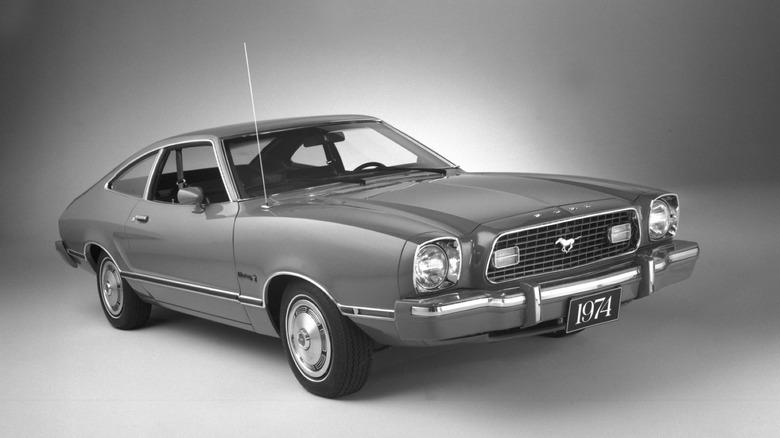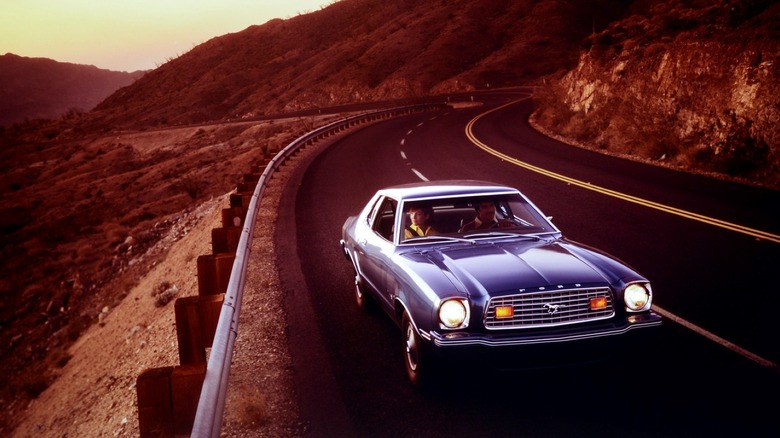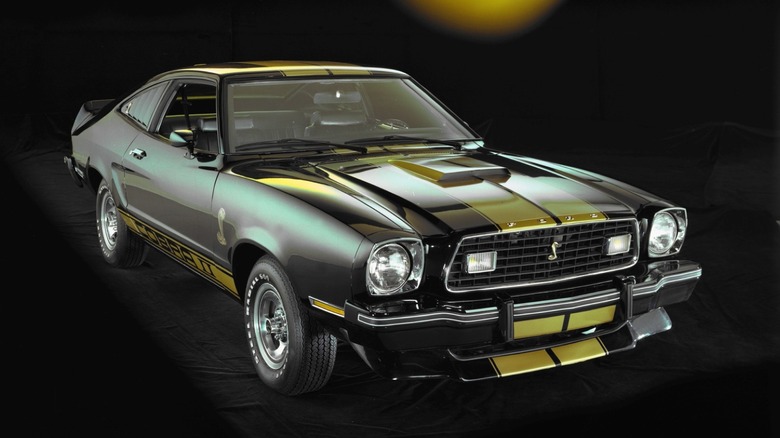Here's Why One Of The Slowest Mustangs Ever Made Was The Most Important
It's safe to say that the Mustang is one of the most famous cars to ever sport Ford's blue oval and quite possibly one of the most iconic vehicles ever made. Since 1964, Ford has made literally millions of them. The success of the Mustang can't be overstated. Today, other Ford vehicles, like the Mustang Mach-E use the moniker despite sharing very little in common with the namesake. But the title carries weight.
For almost 60 years, Mustangs have scarcely disappeared from conversations about popular American performance and muscle cars. Today, Mustangs are available with an efficient turbocharged 2.3L four-cylinder engine up to an absolutely unhinged supercharged 5.2L V8 found in the Shelby GT500 that can melt the rear tires with 760 horsepower. If you just want to cruise around in a convertible, or go drag racing, there's a Mustang for everyone.
Despite its golden reputation, however, the Mustang name hasn't always been associated with the best Ford has to offer.
A Mustang malaise
The mid-1970s was a dark era for American cars. Now dubbed the "Malaise Era," American automakers went from being the frontrunners of style and technology to producing slow hunks of steel that were as big and inefficient as a cruise ship. This was mostly due to a combination of automotive technology catching up to more stringent fuel economy regulations and American automakers' refusal to innovate.
Something needed to change, and Ford's then-president Lee Iacocca thought he had the solution. In 1974, Ford launched the Mustang II, a compact car he thought would be the more successful sequel to the blockbuster pony car.
Ford's new Mustang II looked like a fish combined with a shovel and drove like it too. The first model years of the Mustang II only offered 4- and 6-cylinder engines, reports Motortrend. Despite sharing a platform with the famously maligned Ford Pinto, the Mustang II sold extremely well during its first model year, with more than 300,000 Mustang IIs making their way off dealership lots in 1974 (via CJPonyParts).
Back from the dead
Ford eventually came to its senses and began offering a V8 in the Mustang's direct-to-VHS sequel with models like the Cobra II and King Cobra. Those models sported all the graphics packages and spoilers of a muscle car and looked the part for a performance car. Sales only petered out at the end of the Mustang II's lifespan in 1978.
By 1979, the original Mustang nameplate was resurrected with the new Fox-body Mustangs. The Fox-bodies would then serve as the go-to blank slate for poorly thought-out drag car builds for decades to come.
Even with all the odd engine choices and less-than attractive styling cues, the Mustang II served a valuable purpose for Ford. It revealed that the public was done with the boats of the 1960s. According to Motortrend, car buyers wanted something small and sensible. The Mustang II filled that gap in the market perfectly and had the sales to show for it. By the time the 1980s rolled around, automakers were churning out compacts by the millions.
The Mustang II, ugly as it is, served as a turning point for Ford in 1974, and American automakers as a whole later in the decade.


